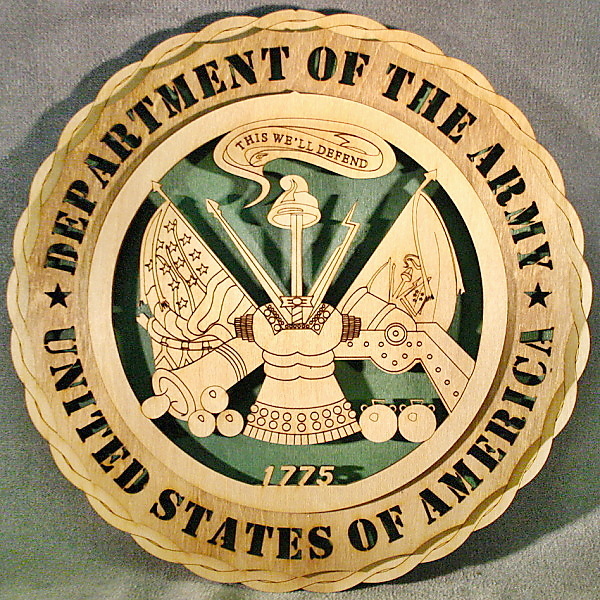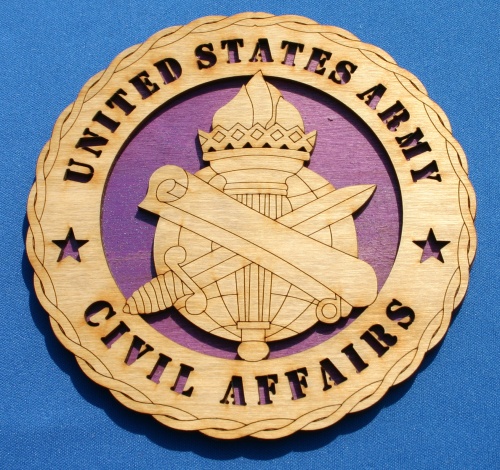18th Engineer Brigade
The 18th Engineer Brigade (Theater Army) is an engineer brigade of the United States Army. It is currently a subordinate unit of 21st Sustainment Command (Theater) and is headquartered at Conn Barracks in Schweinfurt, Germany. Soldiers of the 18th Engineer Brigade provide various supportive duties to other Army units, including construction, engineering, and mechanical work on other Army projects.
The Unit served in Europe during World War II, a fact which was included on its Distinctive Unit Insignia when the 20th Engineer Brigade received one on 10 February 1966. The four corners of the crenelated square allude to their four campaigns in World War II, Normandy, Northern France, Rhineland and Central Europe.
The 18th Engineer Brigade later deployed to Vietnam, during the Vietnam War, where it saw six years of service and supported fourteen campaigns, building infrastructure for military and civilian projects alike. The unit participated in a massive number of road construction projects and airfield constructions, supporting numerous units and operating in areas all over Vietnam. After serving in Vietnam, the unit became attached to Seventh United States Army. It has since undertaken and completed numerous projects in support of US Army, Europe, as well as participated in the conflicts ofOperation Desert Storm, Operation Enduring Freedom, and Operation Iraqi Freedom.
Organization[edit]
The US Army's 18th Engineer Brigade is a subordinate unit of 21st Sustainment Command (Theater). The brigade has been assigned to Europe since February 2007. The brigade is headquartered at Conn Barracks in Schweinfurt, Germany.[1] The brigade's current commander is Colonel Scott A. Petersen, while its Command Sergeant Major is Lauro F. Obeada.
In addition to Headquarters and Headquarters Company and the 243d Engineer Detachment (Construction Management), which is located in Grafenwhoer, Germany two subordinate engineer battalions are permanently attached: the 15th Engineer Battalion headquartered at Grafenwöhr, Germany, and the 54th Engineer Battalionheadquartered at Bamberg, Germany.[2]
History[edit]
World Wars[edit]
The lineage of the 18th Engineer Brigade can be traced back to 29 July 1921, when its predecessor unit, the 347th Engineers (General Service), was first constituted as an Organized Reserves unit. The 347th Engineers would not be activated for almost twenty years, until the United States began its military buildup following its entrance into World War II.[3] The unit was ordered into active military service on 6 May 1942 at Camp Claiborne, Louisiana.[4]
On 1 August 1942, the unit was reorganized and re-designated as the 347th Engineer General Services Regiment. The Regiment deployed to England in February 1944. It entered combat in France on 29 June 1944 and participated in theNormandy, Northern France, Rhineland and Central Europe campaigns of World War II,[5] earning its first Meritorious Unit Commendation. After V-E Day, the Regiment remained on occupation duty in Germany until it was inactivated on 1 June 1946.[4]
On 15 June 1947, the Regiment was reactivated in the organized reserves headquartered in Salt Lake, Utah, and remained there until it was again inactivated on 16 March 1949. On 25 October 1954, the 347th Engineer General Services Regiment was re-designated the 18th Engineer Brigade for the first time and activated as a Regular Armyunit at Fort Leonard Wood, Missouri, where it remained until inactivation on 26 March 1963.[4]
Vietnam War[edit]
The 18th Engineer Brigade was reactivated on 16 July 1965 at Fort Bragg, N.C. and prepared for deployment to Vietnam.[4] The 18th Engineer Brigade entered Vietnam in September 1965 with the responsibility for overseeing all Army Engineering operations in Vietnam until the establishment of the U.S. Army Engineer Command, Vietnam, in late 1966.[4]
Under the command of Colonel C. Craig Cannon, the Brigade prepared for deployment to Vietnam. The Advance Party of the 18th Engineer Brigade arrived at Saigon's Tan Son Nhut Air Base on 3 September 1965. Three days later, Brigadier General Robert R. Ploger assumed command of the Brigade. Within two weeks, the Brigade Headquarters at Tan Son Nhut was fully operational. It had been preceded by the 35th Engineer Group, which built Cam Ranh Bay on a peninsula of sand and in a hostile environment. The brigade assumed responsibility for I Corps and II Corps in the northern part of South Vietnam.[4] The 937th Engineer Group (Combat) at Qui Nhơn was assigned to the Brigade in June 1966.[3]
Its initial activities centered around rapid development of the port facilities, ammunition dumps, base camps and airfields necessary to support the build-up of US combat forces rapidly deploying to Vietnam. During its initial construction phases it also provided support for combat search and destroy missions and defensive operations with the101st Airborne Division near Ninh Hoa and the 4th Infantry Division at Pleiku.[4]
An ammunition storage area was completed at Cam Ranh Bay on 18 January 1969. It took two years for the Brigade to build this complex, which covered over 191,700 square feet (17,810 m2). English Airfield was completed on 21 March 1969 near Qui Nhơn. The runway of this field was 3,600 feet (1,100 m) long, 60 feet (18 m) wide, and was complete with a 150—foot by 150—foot turn around area.[3]
On 3 May 1969, Brigadier General John W. Morris assumed command of the Brigade. Soon afterwards, Brigade engineers finished construction of a cold storage warehouse at the Qui Nhơn Support Command, the first of its kind in Vietnam. Construction of the Tandem Switch Building at Vung Chau Mountain was also completed about this time. This 4,000-square-foot (370 m2) building housed almost US$1 million of communications equipment. During the summer months of 1969, Brigade engineers completed the 200,000-barrel (32,000 m3) capacity Air Force tank farm at Cam Ranh Bay, after laying over 12,000 feet (3,700 m) of pipe to complete the project.[3]
The beginning of 1970 saw the initiation of the 18th Engineers Brigade's Operation Last Chance, a program of command emphasis and organization for motivation and success of that year's engineer operations. The goals of the program were to maintain primary missions of the combat support as well as insure the completion of the many projects planned for the 1970 construction operations.[3]
February 1970 saw the completion of a project begun in the summer of the previous year at Qui Nhơn that replaced a temporary floating steel dock with a more permanent structure which could accommodate six ammo barges at once. The port of Qui Nhơn became one of the few supply points where ammunition for the First and Second Military Regions could be handled in bulk quantities simultaneously.[6] Prior to the completion of this new facility, the handling of ammunition there had to take place in other areas, near public housing and fuel storage depots.[3]
On 3 May 1970, Brigadier General Henry C. Schrader assumed command of the 18th Engineer Brigade. Shortly after this, the most difficult stretch of the roadway that the Brigade had ever undertaken—the 27-kilometer stretch of National Highway QL-11 South in the central highlands region known asTây Nguyên, commonly referred to as the "Good View Pass", was completed. This road had been carved out from a dangerous mountain pass to a national road in less than one year.[3]
The Lines of Communication Program, which represents the most significant contribution that the 18th Engineer Brigade had made to the economic growth of Vietnam, consisted of about 1,500 kilometers of road upgrade from 1967 to 1972.[6] After a slow start in the beginning of this work, the Brigade finished some 560 kilometers of highway reconstruction, and improvement in 1970 and another 450 kilometers were scheduled for completion in 1971 by Brigade units.[3]
In conjunction with the Brigade efforts on the Lines of Communication Program, 18th Brigade engineers was involved in a program of affiliation with ARVN (Army of the Republic of Vietnam) engineers.[6] In addition to continuous training programs which the Brigade established to train ARVN equipment operators, the engineers of the 18th provided technical assistance and logistical support to several projects undertaken by the Vietnamese Army, most notably in the construction of the 3,600-foot (1,100 m) bridge at Tuy Hòa. Upon its completion and opening on 13 February 1971, this bridge became the longest overpass of its type ever constructed in the Republic of Vietnam.[3] It would be one of 77 such bridges that the Brigade would construct in the country.[4]
In support of the XXIV Corps, the 18th Brigade mounted what was described as the "most ambitious engineering effort in Vietnam" at the end of January 1971. The Brigade engineers pushed a roadway across the rugged terrain of the northern Quảng Trị Province to the Laotian border and constructed a 3,200-foot (980 m) by 60-foot (18 m) airfield in little more than a month at Khe Sanh. This construction effort was part of Operation Dewey Canyon II.[3]
On 20 September 1971 the Brigade was inactivated. Over the six years that it served in Vietnam, the 18th Engineer Brigade was involved in 14 of 17 campaigns, earning four Meritorious Unit Commendations.[4]
Post Vietnam[edit]
On 21 October 1977 the 18th Engineer Brigade was reactivated at Karlsruhe, Germany. For 15 years, the Brigade served as the principal construction brigade for theUnited States Army, Europe and 7th Army. During this period, the Brigade performed numerous construction, rehabilitation and renovation missions in military communities and training areas of the 7th Army. These included an extensive range upgrade of the Grafenwohr Major Training Area in the early 1980s and the construction of the Range 23 complex at the Wildflecken Major Training Area in 1989 and 1990. Additionally, the Brigade was responsible for providing topographic support to the European Theater.[4]
On 18 October 2002 the Vice Chief of Staff of the Army approved the USAREUR and 7th Army Concept Plan to activate the Theater Army Engineer Brigade (TAEB). Today, the 18th Engineer Brigade (Theater Army) marks the return to service of the only active duty TAEB.[4] The unit was officially reactivated on 6 June 2004[7][8]Present day[edit]
Operation Enduring Freedom[edit]
The 18th Engineer Brigade was deployed to Afghanistan in support of Operation Enduring Freedom in April 2005. Its primary areas of operation were in and aroundBagram, Kandahar, and Sharana, among other locations.[9] The commander of the Brigade, Colonel Matthew H. Russell issued a memorandum to all soldiers that "preventable accidents" were the largest source of personnel and material losses during the deployment, enforcing a new safety policy throughout the brigade intended to prevent these from occurring.[10]
In 2007, the 18th Engineer Brigade was reassigned to V Corps, taking the place of the 130th Engineer Brigade, which returned to the United States. Some of the 130th's units either merged or were reassigned to the 18th Brigade.[9] During this time, the unit participated in road work, construction of Forward Operating Bases, and other activities that enhanced training readiness in and around Campbell Barracks.
Operation Iraqi Freedom 08-10[edit]
In 2008, the unit was notified of another upcoming deployment to Iraq in support of Operation Iraqi Freedom. It commands three to five engineer battalions in Multinational Division – North. The battalions support individual Brigade Combat Teams of other units in "Task Force Iron", a combat group led by the 1st Armored Division. They are working to rebuild Iraqi infrastructure, with the cooperation of Iraqi engineers, including construction of roads, airfields, and land moving.[11] The unit cased its colors on 29 April 2008, formally signifying the beginning of its deployment to Iraq.[12]
The Brigade spent the first six months of its deployment to Tikrit in central Iraq, working on projects there for Multinational Division-Center under the 10th Mountain Division.[13] On 6 November, the brigade relocated to Kirkuk, unfurling its colors at Forward Operating Base Warrior. The brigade conducted route clearance and construction projects in northern Iraq, while partnered with Iraqi engineers. It replaced the 1st Brigade Combat Team, 10th Mountain Division in Kirkuk and will was under the area of responsibility of Multinational Division-North led by the 1st Armored Division.[14] In February 2009, the brigade again moved, this time toNinewa Province to focus on construction projects in areas in and around Mosul. It was relieved by 2nd Brigade Combat Team, 1st Cavalry Division.[15] On 17 July 2009, the brigade handed over responsibility of Mosul to the 130th Engineer Brigade.[16] The brigade subsequently returned to Schwetzingen, Germany after its 15-month deployment was finished.[17]
Operation Enduring Freedom[edit]
The Brigade deployed to Afghanistan for its second deployment to the country since 2001.[18]






